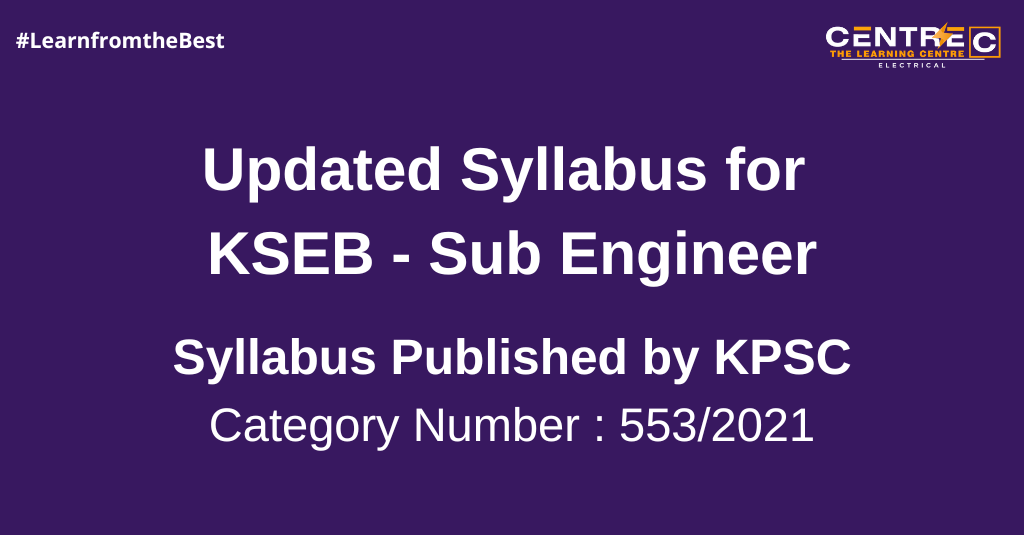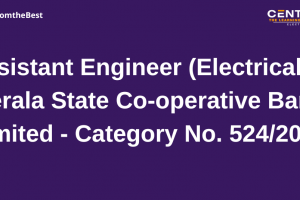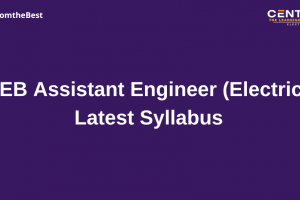
Updated Syllabus for KSEB Sub Engineer (Electrical) – (Cat. No.: 553/2021)
CENTRE-C: ELECTRICAL
Updated Syllabus for KSEB Sub Engineer (Electrical) – (Cat. No.: 553/2021)
SUB ENGINEER (ELECTRICAL)
KERALA STATE ELECTRICITY BOARD LIMITED
Exam Date: 10-02-2023, Friday at 7:15 AM
Download Hall Ticket : From 27th January Onwards
Main Topics: Questions based on Technical educational qualification (Diploma Level)
Maximum Marks : 100
Duration : 1 Hour 30 Minutes
Medium of Question : English
Mode of Exam : OMR/ONLINE (Objective Multiple Choice)
Note :
- Candidates who successfully submitted their confirmation on or before 12.12.2022 can download the Admission Tickets through their One Time Registration Profile in the website www.keralapsc.gov.in from 27.01.2023 onwards.

DETAILED SYLLABUS FOR THE POST OF
SUB ENGINEER (ELECTRICAL)
IN KERALA STATE ELECTRICITY BOARD LIMITED
(Cat.No.: 553/2021)
(Total Marks- 100)
MODULE -I ( 16 Marks )
1 Fundamental Laws and Electric Circuits- Ohm’s Law, Kirchoff‘s laws, Laws of resistance, effect of temperature on resistance-problems.
Series and Parallel circuits-Effective resistance, determine the unknown value of current and voltage in any branch.
2 Network theorems in dc Circuits-Superposition theorem, Thevenin’s theorem, Norton’s theorem, Reciprocity theorem, Maximum power transfer theorem-problems
3 Concepts of power and Energy- single phase and three phase powers-problems, energy consumed for a specific duration-problems.
4 Electrostatics and Electromagnetism- Laws of electrostatics, absolute and relative permittivity, electric field, field strength, flux density, potential at a point. Charging and discharging of capacitors, various combinations of capacitors, energy stored in a capacitor-problems.
Coulomb’s Laws of electromagnetism, magnetic permeability, flux, flux density, reluctance, mmf, B-H curve, Faraday’s laws of electromagnetic induction, statically and dynamically induced emf, energy stored in an inductor, lifting power of an electromagnet.-problems
5 Electrical Measuring instruments-Classification of measuring instruments, various torques, MI and MC types ammeters and voltmeters, measurement of power, energy, resistance, inductance and capacitance, frequency, power factor, time period, phase and phase angle
6 Electrical engineering materials-Conducting materials, semiconductors, magnetic materials and insulators.

MODULE-II (20 Marks)
1 Power-Definition-Equations for three phase and single phase .Power trianglePower factor-Cause and effect of low power factor- methods for pf improvementEquipment for pf correction-problems. Energy- Definition – Units. Power generating stations-Classification-Equipment-Selection of site. Tariff- TypesDetermination of Energy cost based on tariff. Base load-Peak load-Connected loadMaximum demand-Demand factor- load factor- Diversity factor- load curve. Interconnection of power systems- problems.
2 Transmission lines-Classification-Types of conductors and insulators. Causes of insulator failure. Supporting structures-Sag- string efficiency- Problems. Transmission line parameters-transposition-line losses-efficiency-regulation Problems. Ferranti effect-corona-skin effect. Feeder distributor-service mains. Distribution-Overhead (OH) and Underground (UG) distribution system- UG cable laying methods.
3 Relays and Circuit breakers-Classification- construction- operating principle characteristics-protection schemes. Lightning arrestors-Earth connection- Earth resistance values for houses, small substations, large sub stations and generating stations.
4 Laws of Electrolysis- applications- Electric welding-Types. Electric heating Electric Traction-speed time curves-traction effort- specific energy consumption Energy output at drive axle-Problems. Electric braking.
5 Conventional and Non-conventional energy sources. Classification-Solar energy production-collection-storage-applications. Wind energy-production, collection and storage systems.

MODULE –III (16 Marks)
1 Measuring instruments – Classification-working principle-Torques-Errors- Range extension-Voltage-current-single phase and three phase power- energy measurements and measuring instruments- Megger-Insulation tester. Measurement of resistance Wheatstone’s bridge-Volt Ampere method- Potentiometer method. Cable fault detection using Murray and Varley loop tests. Measurements of inductance and capacitance- Maxwell’s bridge, Anderson bridge-Schering Bridge. Problems. Cathode ray oscilloscope-Synchro scope-Frequency meter- TOD meter-Digital meters for voltage, current, frequency measurements. Sensors and Transducers used for electrical measurements.
2 Types of wires –cables-switch-fuse. Ratings of wiring accessories-selection of wiring accessories-specifications- applications. Domestic and industrial wiring schemes-IE rules-IS codes-Circuits and sub circuits. Laws of illumination-lighting schemes illumination levels- space to height ratio-depreciating factor- Utilization factor lighting calculation for buildings and open spaces- problems. Types of lamps used for illumination.
MODULE –IV (16 Marks)
1 DC generators and Motors – Construction-Working principle-Classification-types of windings- split ring and slip ring- DC generator characteristics OCC and load -armature reaction-commutation-equalizer-Critical speed-Critical field resistance Internal and external characteristics-Parallel operation and load sharing-application EMF equation-problems. DC motor –types-characteristics-Voltage equation- speed torque-problems. Starters for DC motors-Methods of speed control-determination of losses and efficiency. Design aspects of DC machines. Problems.
2 Transformer-types-construction-principle of operation-EMF equation-turns ratio losses-efficiency-Problems. Instrument transformers Autotransformer-problems. Induction motors-single phase and three phase- types-construction-principle of operation-Torque-speed-losses-power stages- slip-problems. Starters for single phase and three phase induction motors-speed control methods.
3 Synchronous Generator and motor – Construction-principle of operation Characteristics-parallel operation-Load sharing between generators. Synchronous motor –applications-Excitation- problems.
4 FHP motors-Classification- Construction-working principle-shaded pole motor universal motor-stepper motor-Reluctance motor.
MODULE – V ( 16 Marks)
1 Active and passive components- Formation of semiconductors and PN junction Diodes and Transistors-Types- Characteristics. Rectifiers Classification-Peak Inverse voltage-Ripple factor-Regulation-Efficiency-problems. Types of filters-advantages. -Zener diode –IC Voltage regulators. Wave shaping Circuits-Clipper-Clamber – biased and unbiased. Amplifiers-Classification-Coupling methods-Frequency response- feedback-applications. Oscillators- classification- sinusoidal-Condition for sustained oscillation-principle of operation-Hartley, Colpitts, RC Phase shift, Crystal oscillators. Non-sinusoidal-Multi vibrators-Astable-Mono stable-Bi stable. Schmitt trigger-LTP, UTP. Operational amplifiers-Applications-Characteristics-ideal op amp Configuration-ICs.
2 Number system-Binary-Octal-Hexadecimal-1’s and 2.s complement-logic gates-truth table. K-map, Combinational and sequential logic circuits-classification- working application. Flip Flop-Counters –Shift registers.
MODULE – VI ( 16 Marks)
1 Power electronic devices-UJT, BJT, POWER DIODE, MOSFET, IGBT,DIAC, TRIAC, SCR, Construction –operation-characteristics-Terms related to these devices, SCR-two transistor model- Triggering-commutation techniques. Power electronic circuits- Controlled rectifiers, Chopper, Inverters, Cyclo-converters working, applications and classifications-Electric drives-4 quadrant operation Selection of drive motors. Power supplies- SMPS, UPS, Servo stabilizers, Buck Boost Regulators.
2 Microprocessor.8085 –features-functions-instructions-addressing modes-functional blocks. Micro controller 8051- features-functions-instructions addressing modes functional blocks. Features of AVR-PIC. Micro controllers and Programmable logic controller.
3 Industrial automation – Need of automation, requirements. Control System- control system components, error detectors, servomotors, synchro. Control actions-ON OFF,P,I,PI,PD and PID. Distributed control systems.
NOTE: – It may be noted that apart from the topics detailed above, questions from other topics prescribed for the educational qualification of the post may also appear in the question paper. There is no undertaking that all the topics above may be covered in the question paper.
For Detailed Syllabus :
Get prepared for all the Electrical Engineering exams with a single enrollment!😎
Specially structured to learn each subject from basic to advanced levels,
HIGHLIGHTS
✅ Recorded videos with Unlimited streaming
✅ 300+ hours of lectures
✅Comprehensive coverage of the latest syllabus, including Overseer Grade-I/KSEB Sub-Engineer
✅A highly trained and dedicated faculty team
✅ 150+ total tests
✅ Interactive quizzes
✅Onboard support and doubt clearance
✅Regular performance analysis and personal mentoring
Admissions Open…
1-year validity
Its your high time to choose the right decision!
For admissions call us at
📲 94 97 41 88 77
📲 94 97 41 88 66
CENTRE C ELECTRICAL SOCIAL MEDIA PLATFORMS
Our Social media platforms are exclusively for Electrical Engineering students, job candidates, teachers and all those who have passion for Electrical Engineering.
You will get
- Electrical engineering quiz
- Regular job notifications
- Exam notifications
- E – News
- E – Shots
- Study tips
- Electrical related discussion and all in this group.




